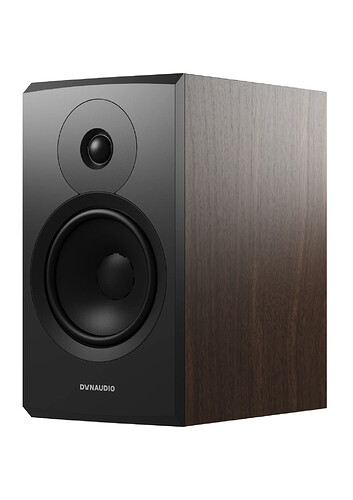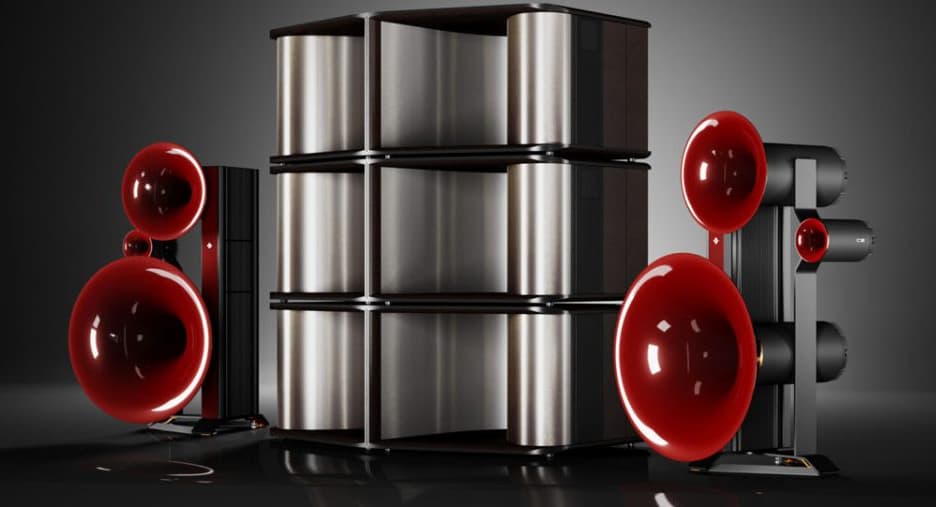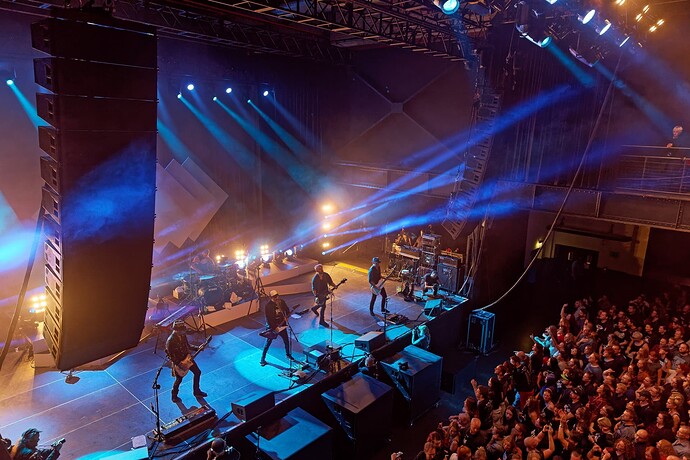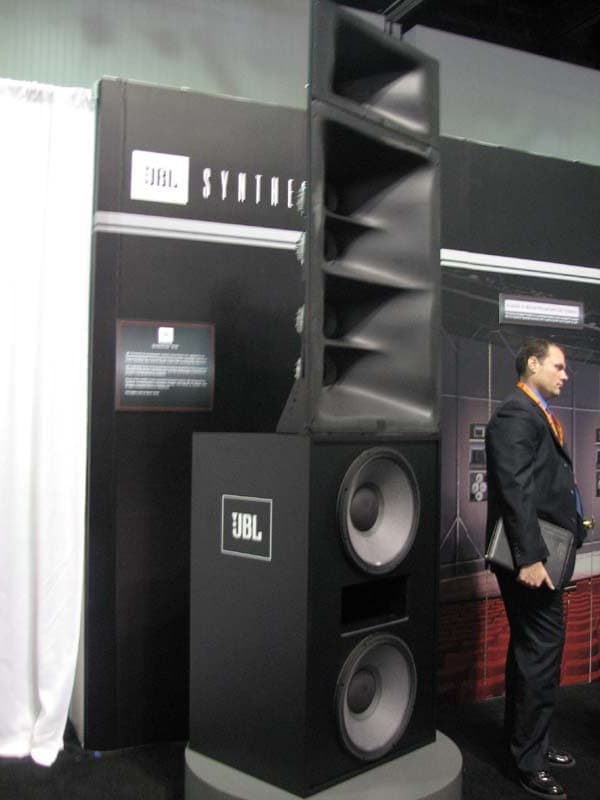DIY beginners build point source speakers like this:
although some of them are better than others they are basically all the same in that, for example, a point source tweeter has a limited output capability. typical dome tweeter like this is about 90 db efficient and can handle maybe 100W peak so about 110 db max, but at concert levels high frequency peaks can be closer to 120db so ultimately this type of speaker is not adequate.
the same kind of math could reveal that even if we were to build a large PA style 3-way with a state of the art 15" woofer … say a 95db woofer with 1 KW continuous power … it would be able to produce 125 db before compression, and perhaps 120 db with compression ( due to voice coil heating ), but again, at BassNectar concert sustained bass levels over 130db were recorded, and this is even though there are legal noise regulations and those were met. so again, as with the tweeter we fall about 10db short.
most people just accept that they will either not reach concert levels at home or will blow their speakers but to me that’s not good enough. i want to reach concert levels without speakers breaking a sweat.
there are two approaches to increasing output beyond what a single point source can produce and those are Horns
and Arrays.
Horns are an older technology while Arrays is a newer technology, but Horns are popular in Home Audio even as Arrays dominate Prosound. This is because horns are cheaper to DIY but arrays are more easily transported and scale better for large venues.
the question is - can the two technologies be mixed ? and why would you want to do it ?
well first of all if you refer to the two pictures i used for horns and arrays you will notice that the horn system from Avantgarde Acoustic of Germany actually uses an array of 6 horn subwoofers …
and also almost every Prosound Line Array uses horn tweeters ( some use Air Motion Transformer or other ribbon-like tweeters, but that is very rare ).
and also if you look at for example JBL Cinema Screen Array systems:
they most assuredly mix horns and arrays in the same design …
so contrary to what the fools on Diy Audio told me you CAN do this and in fact the best designers do it …
( continued )
however when i presented my own design on Diy Audio and asked for criticism - in a sea of retarded bleating of " noo you can’t do this noo you must build Danley Synergy Horn like the rest of us because we are all completely unoriginal and if you want to play with us you must be as well ! " there was one valid comment …
the valid comment was so valid i almost vomited in my mouth.
it was CORRECTLY pointed out that point sources and arrays fall off in SPL at different rates with distance. point sources fall off at 6 db / doubling of distance while line arrays fall off at 3 db / doubling of distance
and of course a theoretical plane array ( nobody builds these ) would fall off at 0 db / doubling of distance in other words - not at all. it would be as loud at a mile distance as at 1 centimeter distance. only application for such a device would be military.
prosound relies on J-Arrays suspended from above. a J-Array is a line array that begins to curl at the bottom into an arc. this provides optimum coverage of the crowd. you can refer to image of array posted a few posts above.
( continued )
so how can we mix line and point sources if they fall off at different rates ? it seems we would only get flat response at one distance from speaker and if we are either closer or further the point and line sources will mis-match in output level ?
indeed they will …
unless …
unless the array is not a line array !
you see the reason a point source decays at 6db / doubling of distance is because 6db is 1/4 power and for a spherical wave front the surface area is proportional to radius squared so with doubling of distance you get 1/4 the power per unit area or -6db.
in other words conservation of energy dictates that as the wavefront moves its energy ( power ) remains the same but as the surface is cut in 1/4 the energy per unit area is cut in 1/4 and thus -6db.
now a line array launches a cylindrical ( as opposed to spherical ) wave front where the area is proportional to radius ( WITHOUT the squared part ). so for 2X radius you only get 2X area and only -3db.
now there is nothing you can do to make a point source fall off slower with distance, but you can make an array fall off faster by CURVING it.
a curved array will no longer launch a cylindrical wave front but one that is closer to a spherical one, thus approaching the 3db per doubling of distance of a point source !
( continued )
now the reason you rarely see such arrays is because it mostly defeats the very purpose of having an array in the first place - which is directivity control and long throw. by curving a line array into an arc you essentially created a point source. why not just use a regular point source at that point ?
well … because you still get more output from multiple speakers than from one.
when you curve the array it begins to act as a point source with the point being the virtual center of the arc.
this allows you to position the point source and the arc array directly on top of each other and realize uniform loudness fall off with distance.
more or less …
( cont )
now if you’re wondering why the JBL Cinema Screen array ( pictured in one of the first posts in this thread ) isn’t curved yet is part of a system with point source HF driver i believe JBL is using a beam steering array - that is the individual drivers of the array get their own DSP processing such as delay and EQ and that is what allows the speaker to shape the wavefront to match the venue it’s installed in.
after all the curving of the array to launch a curved wavefront is really just time delaying the wave by physically moving the speaker. but the wave can be delayed digitally as well, without actually curving the array.
for a company like JBL who make their own DSP solutions it’s better to go the digital route that way one speaker can have many applications with different DSP presets. for us DIYers it is much more practical to physically curve the array - that we every driver can be on the same amp, saving money.
( continued )
the reason i wrote all of this up is because i have actually designed a system that combines a point source midrange with vertical curved woofer array and horizontally curved tweeter array.
i will detail that system later. the point is that it can be done.
the system is brilliant as you can imagine but if i ever build a system of this caliber i will probably just go to a straight line array without any point sources even though it would obviously cost more
because even though my design should achieve fairly good integration of point sources and arrays it is already pushing close to the price of a line array without realizing some of the benefits of line arrays such as the fact that line arrays produce no floor or ceiling reflections.
in other words the system acts as a point source while being almost as expensive as an array and that is a dubious value proposition.
it’s kind of like how a plug in hybrid car is already so expensive you may as well go full electric at this point.
i will document the design simply to expand your minds so you know it can be done, not because it is actually wise to build it. just how a plug-in hybrid car can be done ( in fact i drive one ) but that doesn’t mean it is wise either.
my design does reach my concert level SPL targets with some margin while costing less than a line array and having better pattern control than a point source so it is a success from the perspective of achieving all the design goals …
yet when compared to a line array it seems to give up a lot in performance while also being far more complex to build just to save some money on drivers and amps … OK it saves like $5,000 on drivers and amps but it’s not a budget system so i don’t think it’s a good trade off.
( continued )
this design is FINISHED and i will document it when i have time.
by contrast the Line Array design is in early stages.
for sure the two systems will sound very different because the point source system uses compression drivers and the line array system uses planar magnetic drivers.
which one will sound “better” will depend on personal preference and also the room.
but the array will be far simpler to design and probably perform far better overall. because with array you design a sort of a cross section and then just extrude it. whereas with my “clever” system every part must be optimized individually.
anyway enough talk i will put the design into a separate thread …



